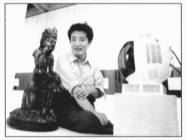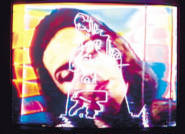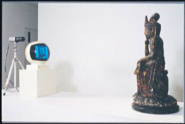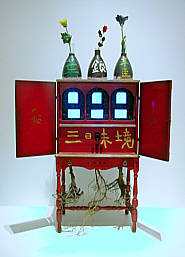|
|
Nam June PAIK
South Korea/United States b.1932
 Nam June Paik and TV Buddha 1976 Courtesy: John Kaldor, Sydney |
Nam June Paik was born in Seoul in 1932, and has lived in New York since 1964. He has played a pioneering role in the development of video, electronic media and multimedia art, and continues to make a major contribution to these media. Paik’s university studies were in music, art history and aesthetics, and he wrote his dissertation on Arnold Schoenberg’s atonal music. His contact with John Cage and other Fluxus artists in the late 1950s was an important influence on his career. Paik’s electronic works combine considered research with a keen appreciation of popular culture at its most experimental.
More information about the artist
 Nam June Paik Global groove (details) 1973 28.30 min. colour videotape with stereo sound Purchased 1996 with a special allocation from the Queensland Government Celebrating the Queensland Art Gallery’s Centenary 1895–1995 Collection: Queensland Art Gallery Photographs: Ray Fulton |
Many of Paik’s works use television to present the diversity and spectacle of late twentieth-century life. In video works such as Paik’s Global groove 1973, fast edit techniques create a hallucinatory stream-of-consciousness experience that incorporates films by other artists, interviews, voice-overs, commercials and popular music. At the close of Global groove, Paik directly acknowledges the viewer and encourages us to actively engage with the television. This work became extraordinarily influential with a generation of artists disenchanted with what they considered to be the elitism of late-modernist art.
 Nam June Paik TV Buddha 1976 Television monitor, video camera, painted wooden Buddha Dimensions variable Collection: John Kaldor, Sydney |
TV Buddha 1976 is one of Paik’s most celebrated assemblages. A wooden statue of Buddha is placed in front of a television monitor. A closed-circuit video camera faces the Buddha and feeds its image back to the monitor. This ironic neo-Dada vision of the Buddha silently contemplating its own televised image was one of the first video installations exhibited in New York’s Museum of Modern Art’s ‘Projects’ series, which highlighted innovations in art.
 Nam June Paik The elements 1989 Lacquer cabinet, 6 television monitors with laser discs, roots, three silk flowers and three glass beakers 195 x 126 x 65cm The Kenneth and Yasuko Myer Collection of Contemporary Asian Art Purchased 1999 with funds from The Myer Foundation A project of the Sidney Myer Centenary Celebration 1899–1999 Gift through the Queensland Art Gallery Foundation Collection: Queensland Art Gallery Photograph: Matthew Kassay |
In The elements 1989, Paik alludes to his Asian heritage by using an ‘oriental’ red lacquer cabinet inscribed with Chinese characters painted in gold. On top of the cabinet are three glass beakers (each containing an artificial flower) and sets of plant roots. Chinese characters painted on the beakers refer to the elements ‘animal’, ‘earth’ and ‘nature’. Six television monitors are set into the cabinet and play video footage featuring early Hollywood film stars Humphrey Bogart and Lauren Bacall alongside avant-garde artists Joseph Beuys and Charlotte Moorman. Paik’s rapid sequence of images also includes famous architectural landmarks, computer-generated flowers, snails, and other aspects of the natural world. The breakneck pace of the video montage appears at odds with the gracious domesticity suggested by the cabinet, but the work perfectly illustrates Paik’s belief in a society with no division between art and life or between art and technology.
This artist is featured in the Education Resource Kit.
List of works in APT 2002
Artists and Works
Print friendly version
|
|
|
|